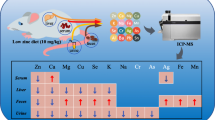Abstract
The effects of low dietary rubidium on plasma biochemical parameters and mineral levels in tissues in rats were studied. Eighteen male Wistar rats, weighing about 40 g, were divided into two groups and fed the diets with or without supplemental rubidium (0.54 vs 8.12 mg/kg diet) for 11 wk. Compared to the rats fed the diet with supplemental rubidium, the animals fed the diet without rubidium supplementation had higher urea nitrogen in plasma; lower rubidium concentration in tissues; lower sodium in muscle; higher potassium in plasma, kidney and tibia, and lower potassium in testis; lower phosphorus in heart and spleen; lower calcium in spleen; higher magnesium in muscle and tibia; higher iron in muscle; lower zinc in plasma and testis; and lower copper in heart, liver, and spleen, and higher copper in kidney. These results suggest that rubidium concentration in tissues reflects rubidium intake, and that rubidium depletion affects mineral (sodium, potassium, phosphorus, calcium, magnesium, iron, zinc, and copper) status.
Similar content being viewed by others
References
F. H. Nielsen, Other elements: Sb, Ba, B, Br, Cs, Ge, Rb, Ag, Sr, Sn, Ti, Zr, Be, Bi, Ga, Au, In, Nb, Sc, Te, Tl, W, inTrace Elements in Human and Animal Nutrition, W. Mertz, eds., Academic, New York, pp. 415–463 (1986).
A. Lasnitzki and E. Szörényi, CCXXIII. The influence of different cations on the growth of yeast cells.Biochem. J. 28, 1678–1683 (1934).
Y.-F. Liu, R.-H. Tang, Q.-X. Zhang, J.-Y. Shi, X.-M. Li, Z.-Q. Liu, and W. Zhao, Stimulation of cell growth ofTetrahymena pyriformis andChlamydomonas reinhardtii by trace elements,Biol. Trace Elem. Res. 9, 89–99 (1986).
R. A. MacLeod and E. E. Snell, The effect of related ions on the potassium requirement of lactic acid bacteria,J. Biol. Chem. 176, 39–52 (1948).
K. Schwarz, Essentiality vs. toxicity of metals, inClinical Chemistry and Chemical Toxicology of Metals, S. S. Brown, eds., Elsevier-New Holland, New York, pp. 3–22 (1977).
I. Lombeck, K. Kasperek, L. E. Feinendegen, and H. J. Bremer, Rubidium—a possible essential trace elemen. 1. The rubidium content of whole blood of healthy and dietetically treated children.Biol. Trace Elem. Res. 2, 193–198 (1980).
O. Eisa and J. Yudkin, Mineral elements in unrefined sugar, and rat reproduction,Int. J. Vitam. Nutr. Res. 59, 77–79 (1989).
M. Anke, L. Angelow, A. Schmidt, and H. Gürtler, Rubidium: an essential element for animal and man?, inTrace Elements in Man and Animals—TEMA, vol. 8, M. Anke, D. Meissner and C. F. Mills, eds., Verlag Media Touristik, Gersdorf, Germany, pp. 719–723 (1993).
M. S. Mameesh and B. C. Johnson, The effect of penicillin on the intestinal synthesis of thiamine in the rat,J. Nutr. 65, 161–167 (1958).
E. Sabbioni, R. Pierta, and E. Marafante, Metal metabolism in laboratory animals and human tissues as investigated by neutron activation analysis: current status and perspectives.J. Radioanal. Chem. 69, 381–400 (1982).
B. L. Glendening, W. G. Schrenk and D. B. Parrish, Effects of rubidium in purified diets fed rats,J. Nutr. 60, 563–579 (1956).
E. I. Hamilton, M. J. Minski, and J. J. Cleary, The concentration and distribution of some stable elements in healthy human tissues from the United Kingdom,Sci. Total Environ. 1, 341–374 (1972/1973).
G. LeBlondel and P. Allain, Effects of thyroparathyroidectomy and of thyroxin and calcitonin on the tissue distribution of twelve elements in the rat.Biol. Trace Elem. Res. 19, 171–183 (1989).
I. G. F. Gilbert, The comparative transport of K+ and Rb+ in normal and malignant rat tissuesin vivo and in liver slices, diaphragm, and tumor slicesin vitro, J. Membrane Biol. 2, 277–299 (1970).
N. Yamagata, The concentration of common cesium and rubidium in human body,J. Radiat. Res. 3, 9–30 (1962).
P. Allain, C. Tafforeau, Y. Mauras, and G. LeBlondel, Determination of rubidium in blood by flame emission spectrometry,Anal. Chim. Acta 165, 257–261 (1984).
G. J. Schmidt and W. Slavin, Inductively coupled plasma emission spectrometry with internal standardization and subtraction of plasma background fluctuations,Anal. Chem. 54, 2491–2495 (1982).
K. Wakimoto, T. Tarumi, and Y. Tanaka, eds.Basic Statistics. Handbook for Statistical Analysis with the Personal Computer, vol. 1, Kyoritsu Syuppans, Tokyo, Japan (1984) (Japanese).
G.-L. Liu, B. Tomiyasu, M. Owari, Y. Nihei, N. Sugimoto, and S. Uchiyama, Source apportionment of particulates collected from artificial space by analysis of individual particles,Environ. Sci. 7, 53–58 (1994) (Japanese).
J. Smith and K. Schwarz, A controlled environment system for new trace element deficiencies,J. Nutr. 93, 182–188 (1967).
F. H. Nielsen, D. R. Myron, S. H. Givand, T. J. Zimmerman, and D. A. Ollerich, Nickel deficiency in rats,J. Nutr. 105, 1620–1630 (1975).
K. Yokoi, Atarashii hissu-biryo-genso no mosaku [Exploring new essential trace elements], inSeitainai-kinzoku-genso [Biological Metal Elements], Y. Itokawa and S. Goto, eds., Kohseikan, Tokyo, Japan, pp. 133–148 (1994).
R. Kilpatrick, H. E. Renschler, D. S. Munro, and G. M. Wilson, A comparison of the distribution of42K and86Rb in rabbit and man,J. Physiol. (London) 133, 194–201 (1956).
S. Ringer, An investigation regarding the action of rubidium and cœsium salts compared with the action of potassium salts on the ventricle of the frog's heart,J. Physiol. (London) 4, 370–379 (1882/1883).
R. F. Loeb, Radioactivity and physiological action of potassium,J. Gen. Physiol. 3, 229–236 (1921).
A. S. Relman, A. M. Roy, and W. B. Schwartz, The acidifying effect of rubidium in normal and potassium-deficient alkalotic rats,J. Clin. Invest. 34, 538–544 (1955).
Author information
Authors and Affiliations
Rights and permissions
About this article
Cite this article
Yokoi, K., Kimura, M. & Itokawa, Y. Effect of low dietary rubidium on plasma biochemical parameters and mineral levels in rats. Biol Trace Elem Res 51, 199–208 (1996). https://doi.org/10.1007/BF02785438
Received:
Revised:
Accepted:
Issue Date:
DOI: https://doi.org/10.1007/BF02785438



